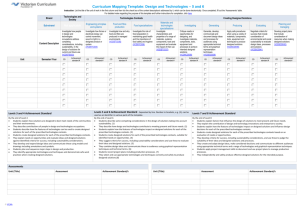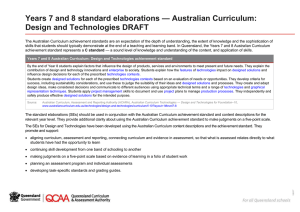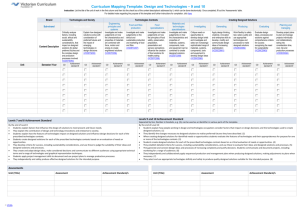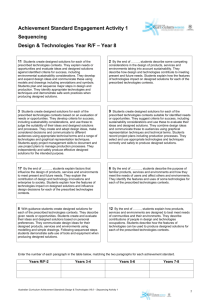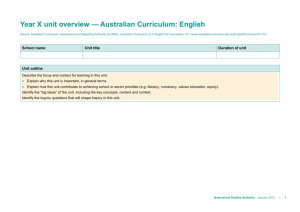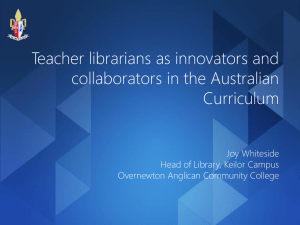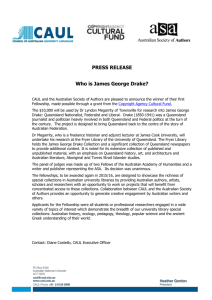Years 5 and 6 standard elaborations * Australian Curriculum
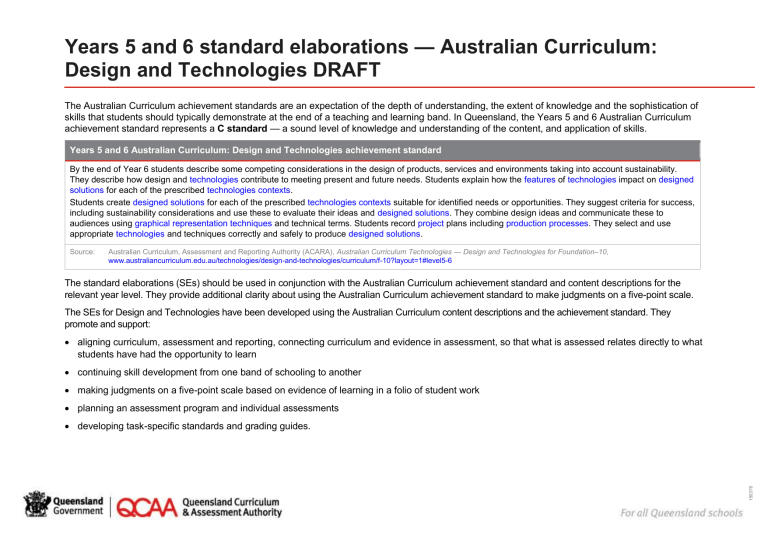
Years 5 and 6 standard elaborations — Australian Curriculum:
Design and Technologies DRAFT
The Australian Curriculum achievement standards are an expectation of the depth of understanding, the extent of knowledge and the sophistication of skills that students should typically demonstrate at the end of a teaching and learning band. In Queensland, the Years 5 and 6 Australian Curriculum achievement standard represents a
C standard
— a sound level of knowledge and understanding of the content, and application of skills.
Years 5 and 6 Australian Curriculum: Design and Technologies achievement standard
By the end of Year 6 students describe some competing considerations in the design of products, services and environments taking into account sustainability.
They describe how design and technologies contribute to meeting present and future needs. Students explain how the features of technologies impact on designed solutions for each of the prescribed technologies contexts .
Students create designed solutions for each of the prescribed technologies contexts suitable for identified needs or opportunities. They suggest criteria for success, including sustainability considerations and use these to evaluate their ideas and designed solutions . They combine design ideas and communicate these to audiences using graphical representation techniques and technical terms. Students record project plans including production processes . They select and use appropriate technologies and techniques correctly and safely to produce designed solutions .
Source: Australian Curriculum, Assessment and Reporting Authority (ACARA), Australian Curriculum Technologies — Design and Technologies for Foundation–10, www.australiancurriculum.edu.au/technologies/design-and-technologies/curriculum/f-10?layout=1#level5-6
The standard elaborations (SEs) should be used in conjunction with the Australian Curriculum achievement standard and content descriptions for the relevant year level. They provide additional clarity about using the Australian Curriculum achievement standard to make judgments on a five-point scale.
The SEs for Design and Technologies have been developed using the Australian Curriculum content descriptions and the achievement standard. They promote and support:
aligning curriculum, assessment and reporting, connecting curriculum and evidence in assessment, so that what is assessed relates directly to what students have had the opportunity to learn
continuing skill development from one band of schooling to another
making judgments on a five-point scale based on evidence of learning in a folio of student work
planning an assessment program and individual assessments
developing task-specific standards and grading guides.
Years 5 and 6
Design and Technologies standard elaborations DRAFT
A B
The folio of a student work has the following characteristics:
C D E comprehensive description of:
some competing considerations in the design of products, services and environments taking into account sustainability
how design and technologies contribute to meeting present and future needs detailed description of:
some competing considerations in the design of products, services and environments taking into account sustainability
how design and technologies contribute to meeting present and future needs description of: identification of: statements about:
some competing considerations in the design of products, services and environments taking into account sustainability
how design and technologies contribute to meeting present and future needs
some considerations in the design of products, services and environments taking into account aspects of sustainability
design and technologies meeting needs
some considerations in the design of products, services and environments
design and technologies meeting needs comprehensive explanation of how the features of technologies impact on designed solutions for each of the prescribed technologies contexts detailed explanation of how the features of technologies impact on designed solutions for each of the prescribed technologies contexts explanation of how the features of technologies impact on designed solutions for each of the prescribed technologies contexts partial explanation of how the features of technologies impact on designed solutions for each of the prescribed technologies contexts statements about features of technologies and designed solutions for each of the prescribed technologies contexts
Years 5 and 6 standard elaborations — Australian Curriculum:
Design and Technologies DRAFT
Page 2 of 10
Queensland Curriculum & Assessment Authority
May 2015
A B
The folio of a student work has the following characteristics:
C identification and explanation of suitable needs or opportunities for each of the prescribed technologies contexts identification and description of suitable needs or opportunities for each of the prescribed technologies contexts identification of suitable needs or opportunities for each of the prescribed technologies contexts
D E identification of aspects of suitable needs or opportunities for each of the prescribed technologies contexts statements about needs or opportunities for each of the prescribed technologies contexts considered combination of design ideas informed combination of design ideas proficient production of designed solutions by selecting and using appropriate technologies and techniques correctly and safely effective production of designed solutions by selecting and using appropriate technologies and techniques correctly and safely combination of design ideas production of designed solutions by selecting and using appropriate technologies and techniques correctly and safely partial combination of design ideas partial production of designed solutions by using technologies and techniques correctly and safely fragmented combination of design ideas comprehensive and effective communication of design ideas to audiences using:
graphical representation techniques
technical terms effective communication of design ideas to audiences using:
graphical representation techniques
technical terms communication of design ideas to audiences using:
graphical representation techniques technical terms partial communication of design ideas to audiences using aspects of:
graphical representation techniques
technical terms fragmented communication of design ideas to audiences using aspects of:
representation techniques
everyday language guided production of designed solutions by using technologies safely
Years 5 and 6 standard elaborations — Australian Curriculum:
Design and Technologies DRAFT
Page 3 of 10
Queensland Curriculum & Assessment Authority
May 2015
A B
The folio of a student work has the following characteristics:
C considered suggestion of criteria for success, including sustainability considerations informed suggestion of criteria for success, including sustainability considerations suggestion of criteria for success, including sustainability considerations
D partial suggestion of criteria for success, including sustainability considerations statements about criteria for success
E considered evaluation of their ideas and designed solutions using criteria for success, including sustainability considerations informed evaluation of their ideas and designed solutions using criteria for success, including sustainability considerations evaluation of their ideas and designed solutions using criteria for success, including sustainability considerations comprehensive record of project plans including production processes. detailed record of project plans including production processes. record of project plans including production processes. explanation of their ideas and designed solutions using criteria for success, including aspects of sustainability considerations statements about their ideas and designed solutions using criteria for success partial record of project plans including aspects of production processes. fragmented record of project plans.
Key Shading emphasises the key aspects of the achievement standard and qualities that discriminate between the A
–E descriptors. Key terms are described overleaf.
Years 5 and 6 standard elaborations — Australian Curriculum:
Design and Technologies DRAFT
Page 4 of 10
Queensland Curriculum & Assessment Authority
May 2015
Notes
Australian Curriculum common dimensions
The SEs describe the qualities of achievement in the two dimensions common to all Australian
Curriculum learning area achievement standards — understanding and skills.
Dimension understanding skills
Description the concepts underpinning and connecting knowledge in a learning area, related to a student’s ability to appropriately select and apply knowledge to solve problems in that learning area the specific techniques, strategies and processes in a learning area
Terms used in Years 5 and 6 Design and Technologies SEs
The following terms are used in the Years 5 and 6 Design and Technologies SEs. They help to clarify the descriptors, and should be read in conjunction with the ACARA Technologies glossary:
www.australiancurriculum.edu.au/technologies/glossary
.
Term apply; applying appropriate aspects clear
Description use or employ in a particular situation fitting, suitable to the context particular parts or features easy to perceive, understand, or interpret collaborating and managing
students learn to work collaboratively and to manage time and other resources to effectively create designed solutions; to do this they:
work individually and in groups to plan, organise and monitor timelines, activities and the use of resources
quality control)
progressively develop the ability to communicate and share ideas throughout the process, negotiating roles and responsibilities and making compromises to work effectively as a team communicate; communication sharing of information and design ideas; includes using graphical representation techniques (e.g. drawing, sketching and modelling) to create innovative ideas that focus on high-quality designed solutions; students progress from basic drawing and modelling to using technical terms and techniques and using digital technologies to produce three-dimensional drawings
comprehensive considered constructed environments detailed and thorough, including all that is relevant thought about deliberately with a purpose; in Design and Technologies, considered
environments developed, built and/or made by people for human and animal
activity, including buildings, streets, gardens, bridges and parks;
include natural environments after they have been changed by people for a purpose
Years 5 and 6 standard elaborations
— Australian Curriculum: Design and
Technologies DRAFT
Page 5 of 10
Queensland Curriculum & Assessment Authority
May 2015
Term creation; create; creating effective environment
Description putting elements together to form a coherent or functional whole; reorganising elements into a new pattern or structure through generating, planning, or producing; creating requires users to put parts together in a new way or synthesise parts into something new and different a new form or product criteria for success detailed digital environment a descriptive list of essential features against which success can be measured; may be predetermined, negotiated with the class or developed by students; compilation of criteria for success involves:
literacy skills to select and use appropriate terminology
clarifying the project task and defining the need or opportunity to be resolved give a practical exhibition or explanation demonstrate description; describe design brief give an account of characteristics or features design processes in Design and Technologies, design processes are:
see also technologies processes
designed solutions a concise statement clarifying the project task and defining the need or opportunity to be resolved after some analysis, investigation and research; it usually identifies
the users, criteria for success , constraints, available resources and timeframe for
the project and may include possible consequences and impacts. the products, services or environments that have been created for a specific
purpose or intention as a result of design thinking, design processes and production
processes; in Design and Technologies Year 5 and 6, students should have opportunities to:
create designed solutions at least once in three
prescribed technologies contexts
experience designing and producing products, services and environments meticulous; including many of the parts
environments that are entirely presented or experienced with digital technologies;
can be a situation, a sphere of activity, or a simulated place (e.g. a social network that provides a digital environment for communicating with friends, software that provides a digital environment for editing photographs) meeting the assigned purpose in a way that produces a desired or intended result
a place or space in which technologies processes operate and/or one of the outputs
of technologies processes ;
environments can be natural , managed ,
Years 5 and 6 standard elaborations
— Australian Curriculum: Design and
Technologies DRAFT
Page 6 of 10
Queensland Curriculum & Assessment Authority
May 2015
Term evaluate; evaluating
explanation; explain features fragmented generating
graphical representations techniques guided identification; identify informed
Description examine and judge the merit or significance of something; students evaluate and make judgments throughout a design process and about the quality and effectiveness of their designed solutions and those of others; to do this they:
identify criteria for success (progressively students develop criteria which become
increasingly more comprehensive)
consider the implications and consequences of actions and decision-making
determine effective ways to test and judge their designed solutions
reflect on processes and transfer their learning to other design opportunities provide additional information that demonstrates understanding of reasoning and/or application a distinctive attribute, characteristic, property or quality of something (e.g. an object, material, living thing, system or event) disjointed or isolated students develop and communicate ideas for a range of audiences; to do this they:
create change, make choices, weigh up options, consider alternatives and document various design ideas and possibilities
use critical and creative thinking strategies to generate, evaluate and document ideas to meet needs or opportunities that have been identified by an individual, group or wider community
evaluate, justify and synthesise what they learn and discover
use graphical representation techniques when they draw, sketch, model and create innovative ideas that focus on high-quality designed solutions; generating creative and innovative ideas involves thinking differently; it entails proposing new approaches to existing problems and identifying new design opportunities considering preferred futures; generating and developing ideas involves identifying various competing factors that may influence and dictate the focus of the idea techniques used to communicate ideas and plans (e.g. sketching, drawing, modelling, making patterns, technical drawing, computer-aided drawing); in Design and Technologies Years 5 and 6, students:
represent objects and ideas in a variety of forms (e.g. thumbnail sketches, models, drawings, diagrams and storyboards) to illustrate the development of designed solutions
use a range of techniques (e.g. labelling and annotating sequenced sketches and diagrams) to illustrate how products function
recognise and use a range of drawing symbols in context to give meaning and direction visual and/or verbal prompts to facilitate or support independent action to establish or indicate who or what someone or something is having relevant knowledge; being conversant with the topic; in Design and Technologies, informed refers to the underpinning knowledge,
understanding and skills of processes and production skills when solving problems
and creating solutions
Years 5 and 6 standard elaborations
— Australian Curriculum: Design and
Technologies DRAFT
Page 7 of 10
Queensland Curriculum & Assessment Authority
May 2015
Term investigating
managed environments materials
Description students critique, explore and investigate needs, opportunities and information; as creators and consumers they:
critically reflect on the intention, purpose and operation of technologies and designed solutions
examine values, analyse, question and review processes and systems
reflect on how decisions they make may have implications for the individual, society and the local and global environment, now and in the future
explore and investigate technologies, systems, products, services and environments as they consider the needs of society
progressively develop effective investigation strategies and consider the contribution of technologies to their lives and make judgments about them;
students may respond to design briefs or develop design briefs in response to
needs and opportunities
environments coordinated by humans (e.g. farms, forests, marine parks,
waterways, wetlands, storage facilities) used to create products or environments and their structure can be manipulated by applying knowledge of the origins, structure, characteristics, properties and uses; natural (e.g. animals, food, fibre, timber) and fabricated materials (e.g. metals, alloys, plastics, textiles)
environments in which humans do not make significant interventions (e.g. oceans,
natural woodlands, national parks) attempted; incomplete evidence provided
natural environments partial prescribed technologies contexts processes and production skills producing
product; products production processes
) the skills needed to create designed solutions ;
see also technologies processes
actively realising (making) designed solutions using appropriate resources and means of production; students learn and apply a variety of skills and techniques to make products, services or environments designed to meet specific purposes and user needs; to do this they:
apply knowledge about components, materials and their characteristics and
properties to ensure their suitability for use
learn about the importance of adopting safe work practices
develop accurate production skills to achieve quality designed solutions
develop the capacity to select and use appropriate materials, systems, components, tools and equipment
use work practices that respect the need for sustainability;
the use of modelling and prototyping to accurately develop simple and complex
physical models supports the production of successful designed solutions one of the outputs of technologies processes, the end result of processes and production; products are the tangible end results of natural, human, mechanical, manufacturing, electronic or digital processes to meet a need or want in Design and Technologies, the technologies context-specific processes used to transform technologies into products, services or environments (e.g. the steps used for producing a product)
Years 5 and 6 standard elaborations
— Australian Curriculum: Design and
Technologies DRAFT
Page 8 of 10
Queensland Curriculum & Assessment Authority
May 2015
Term proficient project project management prototype; prototyping service statement suggestion suitable sustainable; sustainability systems
Description competent or skilled in doing or using something; in Design and Technologies, proficient means using knowledge and understanding of technologies in a skilful and adept application to produce high-quality design solutions the set of activities undertaken by students to address specified content, involving:
understanding the nature of a problem, situation or need
creating, designing and producing a solution to the project task
documenting the process; a project has:
a benefit, purpose and use a user or audience who can provide feedback on the success of the solution
limitations to work within
a real-world technologies context influenced by social, ethical and environmental
issues
criteria for success to judge its success
the responsibility for planning, organising and controlling resources, monitoring timelines and activities and completing a project to achieve a goal that meets identified criteria for judging success; detailed project management plans incorporate elements such as sequenced time, cost and action plans to manage a range of design tasks safely, and to enable changing direction when necessary to successfully complete design tasks; students should also identify and establish safety procedures that minimise risk and manage projects with safety and efficiency in mind, maintaining safety standards and management procedures to ensure success a trial product or model built to test an idea or process to inform further design development; a prototype can be developed in the fields of service, design, electronics or software programming; its purpose is to see if and how well the design works; prototypes are tested by users and systems analysts; prototyping is the process of developing a prototype; it provides specifications for a real, working product or system rather than a virtual or theoretical one
one of the outputs of technologies processes , the end result of processes and
production; services
are the less tangible outcome (compared to products ) of technologies
processes to meet a need or want; they may involve development or maintenance of a system and include catering, cloud computing (software as a service), communication, transportation and water management; services can be communicated by charts, diagrams, models, posters and procedures a sentence or assertion put forward for consideration appropriate, fitting supports the needs of the present without compromising the ability of future generations to support their needs the structure, properties, behaviour and interactivity of people and components
(inputs, processes and outputs) within and between natural , managed ,
Years 5 and 6 standard elaborations
— Australian Curriculum: Design and
Technologies DRAFT
Page 9 of 10
Queensland Curriculum & Assessment Authority
May 2015
Term technologies technologies contexts technologies processes use of
Description the materials, data, systems, components, tools and equipment used to create solutions for identified needs and opportunities, and the knowledge, understanding and skills used by people involved in the selection and use of these in Design and Technologies, these are the contexts that students can focus on when using processes and production skills to design and produce products, services and environments; the prescribed technologies contexts are:
engineering principles and systems
food and fibre production
food specialisations (Years 5 through 10 only)
materials and technologies specialisations (Years 5 through 10 only) the processes that allow the creation of a solution for an audience (end user, client or consumer) and involve the purposeful use of technologies and other resources and appropriate consideration of impact when creating and using solutions; typically require critical and creative thinking such as: computational, design or systems thinking in Design and Technologies, technologies processes involve:
technologies-specific production processes
to operate or put into effect
Years 5 and 6 standard elaborations
— Australian Curriculum: Design and
Technologies DRAFT
Page 10 of 10
Queensland Curriculum & Assessment Authority
May 2015
